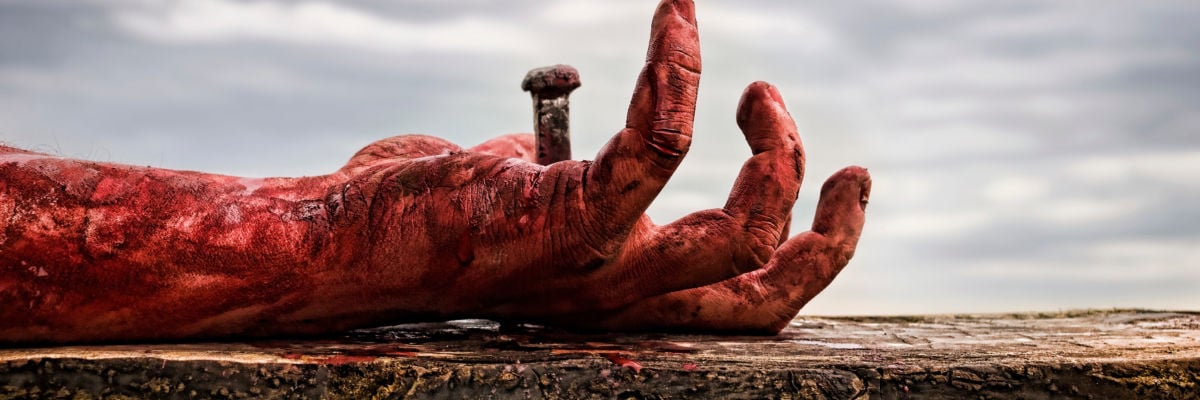
“And you shall know that I am the Lord, when I open your graves, and raise you from your graves, O my people” (Ezek. 37:13).
“You shall know that I am the Lord.” That’s a common refrain in the prophets. Sometimes it’s even simpler, inserted, in a way that doesn’t quite make sense to modern ears, after other statements that do not seem to connect: “I am the Lord.” Remember that the divine name itself, unpronounceable by pious Jews even to this day, is likely a variation of the Hebrew verb “to be.” When Jesus, in another part of John, makes his series of “I am” statements, part of the scandal among his audience was that he spoke so freely in association with the holy name, treating it as something familiar.
Often in the prophets, like in the older stories of the Exodus, God makes certain promises as signs to vindicate his identity. Who is he? He is the God of Abraham, Isaac, and Jacob. He is the God who promises to the patriarchs the blessing of descendants who will fill the face of the earth and be a blessing to all peoples. He is the God who promises to the congregation of Israel at Sinai that he will watch over them and protect them in an exclusive relationship. And at every step, he gives them signs: circumcision, the law, not to mention countless miracles. These, he tells them, are how you know that he is who he says he is.
With that background, we can almost understand the response of Zechariah in Luke 1, when he asks the angel Gabriel, “How shall I know this to be true?” In many homilies and talks over the years, I’ve pointed out the difference between the two annunciations in Luke – the one to Zechariah and the one to Mary (which we’ll celebrate this coming Saturday). Mary is praised for her faith and trust, for the pious wonder behind her famous question, “How can this be?” In contrast to that, Zechariah’s question can come across as skeptical or even cynical. But that’s not really fair to the tradition Zechariah represents, which is the whole tradition of Israel. After all, as St. Paul says in the opening chapter of 1 Corinthians, “Jews demand signs and Greeks seek wisdom” (1 Cor. 1:22). God has consistently given people signs to demonstrate the truth of his revelation.
That this economy of signs is ending, or at least changing, should be clear from the Annunciation to Mary. For her, the thing itself—the incarnation of God the Son—is the reality for which there can be no adequate secondary sign. And, as if to drive the point home, we see people in the Gospels, over and over again, rejecting the additional signs offered by our Lord as often as they accept them.
The signs are leading somewhere. For Paul, in making that statement in 1 Corinthians, does not mean to suggest that there are no signs in the New Covenant. In fact, there are; we call them sacraments. But these signs function mostly as confirmation of a faith that already exists. Their principal purpose is not to prove or convince.
But the signs leading up to the crucial events of Holy Week are signs of the older sort. St. John’s Gospel gives six of them leading up to the final seventh sign of the Resurrection. Last week, we read the fifth sign, the healing of the man born blind. Today we see the sixth, the raising of Lazarus. And the order here suggests that, as the penultimate sign, there is little left to show. If you can witness the raising of the dead and not believe that this man is who he says he is, no sign will convince you. Hence Paul’s frustration in 1 Corinthians with those who seek further signs.
It should be obvious that the Church wishes us to see here in the raising of Lazarus a partial fulfillment of the sign given in Ezekiel: “You shall know that I am the Lord, when I open your graves, and raise you from your graves, O my people.” Martha, at least, seems to understand this in her tentative and then confident proclamation of faith: first, “I know that whatever you ask of God, God will give you,” and then “I have come to believe that you are the Christ, the Son of God.” The final fulfillment is yet to come, of course—it is the resurrection of the dead that we “look forward to” at the end of the Creed.
Despite this connection, modern readers and scholars of Ezekiel love to point out that, in context, Israel’s hope was primarily political, and that the restoration of the dry bones is the restoration of the nation. But this is to reject, like the elite Sadducees of Jesus’ time, the prophetic and rabbinic hope of resurrection. Certainly the prophecy did refer to a political resurrection for the people of Israel, but, as pious Jews through the ages came to understand, such political resurrection would be meaningless and temporary without a solution to the problem of death. To see Israel’s life as a mere political life, devoid of any eternal significance, would be to misunderstand the entirety of the Torah. Israel herself is a sign that points to something—ultimately to some-one.
After all, the raising of Lazarus is also just a sign. It is not the thing itself. Lazarus, historically, died again. He was buried the second time, according to tradition, on the island of Cyprus, after many more years of following Jesus. As St. Lazarus knew, his resuscitation was not the resurrection of the dead to which we look forward, but a sign and a shadow of it. Only in Christ do we see the thing first revealed.
Still, this is a sign with real power. If there was any remaining doubt that Jesus’ kingdom was “not of this world,” here was a final blow against Jesus as mere political agitator. St. Thomas hits the nail on the head in what has got to be one of the more wonderfully understated lines in the whole gospel drama: “Let us also go, that we may die with him” (John 11:16).
For that is what we are called to do, whether Thomas realizes it at the time or not. Placed here at the entrance of Passiontide, we turn our minds in a new way to the task set before us: to walk with Jesus in his final days, to be abandoned with him on Holy Thursday, to die with him on Good Friday, to rise with him on Easter Sunday. So this final sign before the Passion isn’t just a sign of who Jesus really is—the God of Israel, come to fulfill his promises. It is also an invitation to follow him.
This is, in a way, the true final sign. How do we know this to be true? How do we know that he is the Lord? How is it that these strange events are necessary for our salvation? These are not questions that can be fully answered by information alone, as if the atonement were merely a set of figures on an account book. They have to be lived, as they were for the first disciples.
We might be tempted to think of the Church’s liturgy over the next couple of weeks as a kind of explanatory drama designed to help us understand or imagine the events in question. We might be tempted to assign “meaning” to these rituals, as if they are capable of being translated into some other language. I encourage you to resist those temptations. Dig in, rather, to the ritual experience that Holy Church provides—whether in the liturgies themselves or in the ways that we might join with them at home in the “domestic church.” Salvation is not merely an idea, but an action, a movement, away from sin and death toward the life and glory of God. Our goal in the Church’s rituals is not just to think about these things, but to do them. The fact that these actions are saturated with symbolism does not make them any less real.
Above all, trust that, following the way of the cross, we will reach the promised resurrection—both the resurrection of the body and the resurrection of the soul. However dried out and cut off we may feel, Jesus himself, in his death and resurrection, is the sign of God’s promises: “And I will put my Spirit within you, and you shall live, and I will place you in your own land; then you shall know that I, the Lord, have spoken, and I have done it, says the Lord” (Ezek. 37:14).



